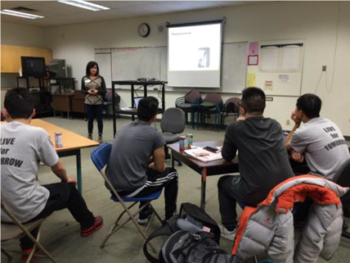
Robin Schooley of ILS Young Worker team delivering a presentation to the WorkSafeBC Youth Leadership Team from Richmond high schools.
“Live for tomorrow” is the motto created by participants in a new youth leadership project for workplace safety.
It all started when Richmond School District 38 and WorkSafeBC decided to work together on this pilot project that would teach youth about their rights, what to expect from employers, and how to speak up when necessary.
The motivator of this project is Terri Lockhart, the school district’s coordinator of career programs. She has been supporting leadership programs for youth and for this project found 30 interested young people, thanks to suggestions from teachers of planning and leadership throughout Richmond.
“She has been a real driver of the group and we certainly couldn’t have done it without her,” says Helen Chandler, a WorkSafeBC industry specialist on young workers.
The group meets once a semester at one of the Richmond secondary schools. They check in to report on the workplace safety events they held at school and brainstorm new ways to share their messages. For example, one school has a regular event called WorkSafe Wednesdays, in which they announce facts or statistics related to young worker safety during the morning announcements.
Other schools have borrowed WorkSafeBC’s safety spin wheel and set up a table during lunch time where they ask the students questions and give them small prizes. Another group did a scavenger hunt with trivia questions and clues around the school.
For WorkSafeBC, the youth leadership project offers a good chance for getting insight into programs and messaging for young workers. Between meetings, participants keep in touch through the student council’s private Facebook Group.
“They don’t hold back in telling us what works and what doesn’t,” Helen says.
Participants gain awareness of their own safety, and when they have a safety message to share with their peers, it has a different effect.
“Having safety information come from their peers is much more effective than having it come from WorkSafeBC or even their teachers,” Helen says.
WorkSafeBC would like to expand this pilot project to include other school districts that might be interested. Do you know any people from BC school districts who might be interested? I can hook you up.


